2、python 科学计算及数据可视化
2017-12-29 17:47
609 查看
NumPy
ndarray, n维度数组对象(矩阵)
* 所有元素必须是相同类型
* ndim属性,维度个数
*shape属性,各维度大校
*dtype属性,数据类型
结果
创建ndarray
运行结果:
矢量化:
矢量运算,相同大小的数组间运算应用在元素上
矢量和标量运算,广播将标量广播到各个元素上
结果
切片
结果:
维度转换:
*转置 transpose
*高维数组转换要制定维度编号(0,1,2...)
维度axis 0,1,2 (列为0 ,1为行,再增加就类推)
运行结果:
常用函数
运行结果
常用函数:
运行结果:
读取文本数据:
运行结果:
matplotlib
运行结果
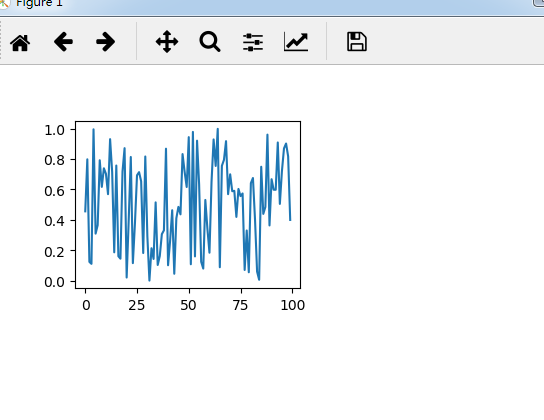
高斯分布:
结果:
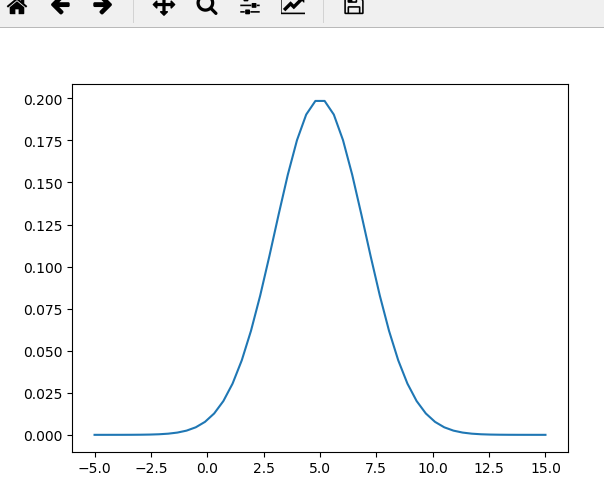
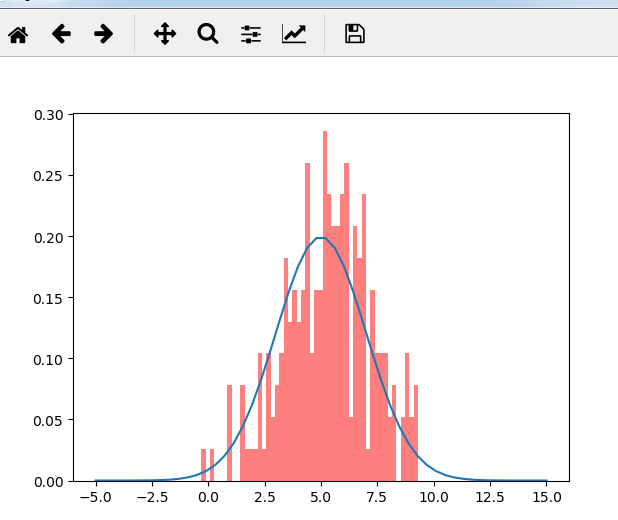
散点图:
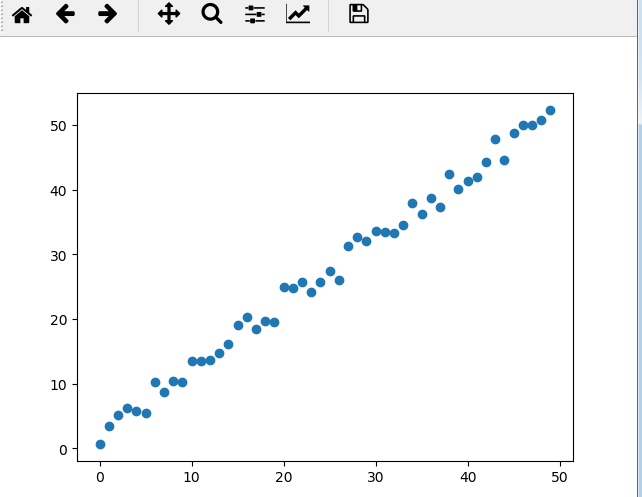
柱状图:
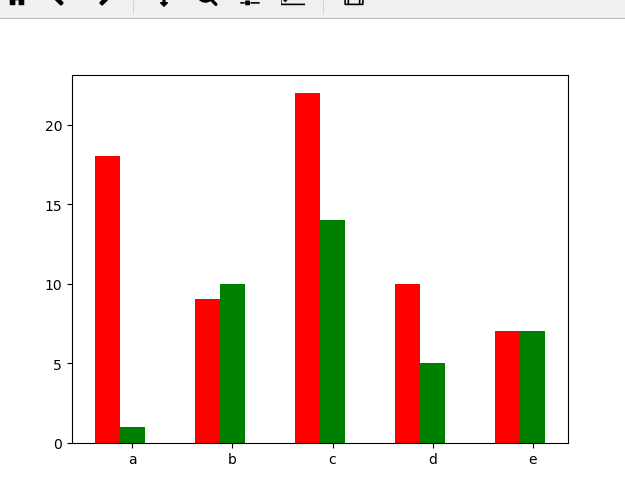
矩阵绘图
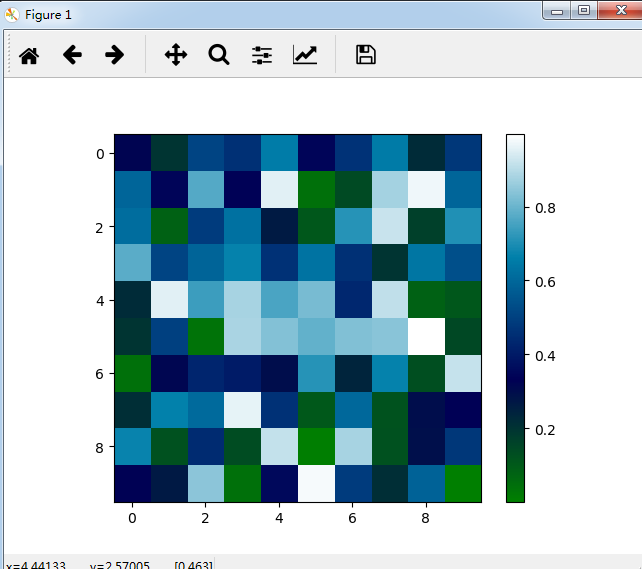
ndarray, n维度数组对象(矩阵)
* 所有元素必须是相同类型
* ndim属性,维度个数
*shape属性,各维度大校
*dtype属性,数据类型
# -*- coding: utf-8 -*- import numpy as np if __name__ == '__main__': # ndarray 多维数组 rand = np.random.rand(2, 3) print rand print type(rand) print "维度个数", rand.ndim print "各维度大小",rand.shape print "数据类型", rand.dtype
结果
C:\Anaconda2\python.exe F:/python01/lect002/lect002_numpy.py [[ 0.21023712 0.97845314 0.75712835] [ 0.8307807 0.2628768 0.69734118]] <type 'numpy.ndarray'> 维度个数 2 各维度大小 (2L, 3L) 数据类型 float64 Process finished with exit code 0
创建ndarray
# -*- coding: utf-8 -*- import numpy as np if __name__ == '__main__': # 创建一维数组 lis = range(10) print lis ndarray = np.array(lis) print ndarray print ndarray.shape print ndarray.ndim print "-------创建二维数组--------------" lis2 =[range(10),range(10)] print lis2 array = np.array(lis2) print array print array.shape print "-----创建特殊数组 参数是元组----------" print np.zeros((3,3)) print np.ones((2,2)) # 随机的数组 print np.empty((4,4)) print np.empty((2,2),int) print "----创建连续的数组----------------" arange = np.arange(10) print arange print "-------数据类型转换-----------------" zeros = np.zeros((3, 4), dtype=float) print zeros print zeros.dtype astype = zeros.astype(int) print astype print astype.dtype
运行结果:
C:\Anaconda2\python.exe F:/python01/lect002/lect002_numpy02.py [0, 1, 2, 3, 4, 5, 6, 7, 8, 9] [0 1 2 3 4 5 6 7 8 9] (10L,) 1 -------创建二维数组-------------- [[0, 1, 2, 3, 4, 5, 6, 7, 8, 9], [0, 1, 2, 3, 4, 5, 6, 7, 8, 9]] [[0 1 2 3 4 5 6 7 8 9] [0 1 2 3 4 5 6 7 8 9]] (2L, 10L) -----创建特殊数组 参数是元组---------- [[ 0. 0. 0.] [ 0. 0. 0.] [ 0. 0. 0.]] [[ 1. 1.] [ 1. 1.]] [[ 1.56067605e-316 1.56231146e-316 1.56229960e-316 1.56231502e-316] [ 1.56231976e-316 1.56231620e-316 1.56231027e-316 1.56230435e-316] [ 1.56231265e-316 1.56221423e-316 1.56229842e-316 1.56223557e-316] [ 1.56221423e-316 1.56231502e-316 1.56221423e-316 1.56239091e-316]] [[16843009 16843009] [16843009 16843009]] ----创建连续的数组---------------- [0 1 2 3 4 5 6 7 8 9] -------数据类型转换----------------- [[ 0. 0. 0. 0.] [ 0. 0. 0. 0.] [ 0. 0. 0. 0.]] float64 [[0 0 0 0] [0 0 0 0] [0 0 0 0]] int32 Process finished with exit code 0
矢量化:
矢量运算,相同大小的数组间运算应用在元素上
矢量和标量运算,广播将标量广播到各个元素上
# -*- coding: utf-8 -*- import numpy as np if __name__ == '__main__': # ndarray的矢量化 arange = np.arange(3) np_arange = np.arange(3, 6) print arange print np_arange print arange+np_arange print 2*arange
结果
C:\Anaconda2\python.exe F:/python01/lect002/lect002_numpy03.py [0 1 2] [3 4 5] [3 5 7] [0 2 4]
切片
# ndarray的切片 n = np.arange(12) print n print n[2:4] reshape = n.reshape(3, 4) print reshape print reshape[1] print reshape[:2, 2:4] #条件索引 多个条件使用 & 或者 | year_array = np.array([[2000, 2001, 2002], [2003, 2004, 2005], [2006, 2007, 2008]]) print year_array is_year_after_2004 = year_array>2004 print is_year_after_2004 # 最后的数组是一维数组 print year_array[is_year_after_2004]
结果:
[ 0 1 2 3 4 5 6 7 8 9 10 11] [2 3] [[ 0 1 2 3] [ 4 5 6 7] [ 8 9 10 11]] [4 5 6 7] [[2 3] [6 7]] [[2000 2001 2002] [2003 2004 2005] [2006 2007 2008]] [[False False False] [False False True] [ True True True]] [2005 2006 2007 2008]
维度转换:
*转置 transpose
*高维数组转换要制定维度编号(0,1,2...)
维度axis 0,1,2 (列为0 ,1为行,再增加就类推)
import numpy as np if __name__ == '__main__': rand = np.random.rand(2, 3) print rand print rand.transpose() print rand.transpose(1,0) random_rand = np.random.rand(2, 3, 4) print random_rand print random_rand.transpose(1,0,2)
运行结果:
C:\Anaconda2\python.exe F:/python01/lect002/lect002_transfer.py [[ 0.55045248 0.67183506 0.68011376] [ 0.12724309 0.18932144 0.49323607]] [[ 0.55045248 0.12724309] [ 0.67183506 0.18932144] [ 0.68011376 0.49323607]] [[ 0.55045248 0.12724309] [ 0.67183506 0.18932144] [ 0.68011376 0.49323607]] [[[ 0.10286321 0.33290148 0.69265064 0.14793831] [ 0.21150213 0.06612363 0.62607419 0.2727764 ] [ 0.82718353 0.97353082 0.29052988 0.98272131]] [[ 0.63500486 0.57253861 0.19738308 0.32425578] [ 0.91304141 0.23796068 0.46761624 0.74755873] [ 0.95759612 0.61779126 0.64942146 0.66568574]]] [[[ 0.10286321 0.33290148 0.69265064 0.14793831] [ 0.63500486 0.57253861 0.19738308 0.32425578]] [[ 0.21150213 0.06612363 0.62607419 0.2727764 ] [ 0.91304141 0.23796068 0.46761624 0.74755873]] [[ 0.82718353 0.97353082 0.29052988 0.98272131] [ 0.95759612 0.61779126 0.64942146 0.66568574]]] Process finished with exit code 0
常用函数
# -*- coding: utf-8 -*- import numpy as np # 通用函数 if __name__ == '__main__': rand = np.random.rand(2, 3) print rand # 向上取整 print np.ceil(rand) # 向下取整 print np.floor(rand) # 四舍五入 print np.rint(rand) # 判断是否是nan print np.isnan(rand)
运行结果
C:\Anaconda2\python.exe F:/python01/lect002/lect002_numpy005.py [[ 0.30769093 0.60175561 0.10805398] [ 0.45100185 0.2759167 0.08227846]] [[ 1. 1. 1.] [ 1. 1. 1.]] [[ 0. 0. 0.] [ 0. 0. 0.]] [[ 0. 1. 0.] [ 0. 0. 0.]] [[False False False] [False False False]] Process finished with exit code 0
常用函数:
# -*- coding: utf-8 -*- import numpy as np if __name__ == '__main__': rand = np.random.rand(2, 3) print rand where = np.where(rand > 0.5, 1, 0) print where print "--------------------------------" reshape = np.random.rand(12).reshape(3, 4) print reshape print np.sum(reshape) # 同一列相加 print np.sum(reshape,axis=0) # 同一行相加 print np.sum(reshape,axis=1) print np.any(reshape>0.5) print np.all(reshape>0.5) print "=======================" ranage = np.array([1, 2, 3, 4, 2, 3]) print ranage print np.unique(ranage)
运行结果:
C:\Anaconda2\python.exe F:/python01/lect002/lect002_numpy_where.py [[ 0.84612841 0.12221903 0.58630742] [ 0.03635271 0.55302229 0.4427165 ]] [[1 0 1] [0 1 0]] -------------------------------- [[ 0.40210732 0.46221939 0.38169504 0.85805883] [ 0.55928184 0.5255376 0.07921358 0.69144592] [ 0.99119277 0.85753681 0.80399766 0.38187579]] 6.99416254185 [ 1.95258192 1.8452938 1.26490628 1.93138054] [ 2.10408058 1.85547893 3.03460303] True False ======================= [1 2 3 4 2 3] [1 2 3 4] Process finished with exit code 0
读取文本数据:
# -*- coding: utf-8 -*-
import numpy as np
if __name__ == '__main__':
file_name ="../presidential_polls.csv"
loadtxt = np.loadtxt(fname=file_name,
delimiter=",", # 分隔符
dtype=str, # 数据类型
usecols=(0, 2, 3) # 指定读取的索引列
)
print loadtxt,loadtxt.shape
print "===================================="
np_loadtxt = np.loadtxt(fname=file_name,
delimiter=",", # 分隔符
skiprows=1, # 跳过的行
dtype={"names": ('cycle', 'type', 'matchup'),
"formats": ('i4', 'S15', 'S50')},
usecols=(0, 2, 3)
)
print np_loadtxt, np_loadtxt.shape运行结果:
C:\Anaconda2\python.exe F:/python01/lect002/lect002_readtxt.py [['cycle' 'type' 'matchup'] ['2016' '"polls-plus"' '"Clinton vs. Trump vs. Johnson"'] ['2016' '"polls-plus"' '"Clinton vs. Trump vs. Johnson"'] ..., ['2016' '"polls-only"' '"Clinton vs. Trump vs. Johnson"'] ['2016' '"polls-only"' '"Clinton vs. Trump vs. Johnson"'] ['2016' '"polls-only"' '"Clinton vs. Trump vs. Johnson"']] (10237L, 3L) ==================================== [(2016, '"polls-plus"', '"Clinton vs. Trump vs. Johnson"') (2016, '"polls-plus"', '"Clinton vs. Trump vs. Johnson"') (2016, '"polls-plus"', '"Clinton vs. Trump vs. Johnson"') ..., (2016, '"polls-only"', '"Clinton vs. Trump vs. Johnson"') (2016, '"polls-only"', '"Clinton vs. Trump vs. Johnson"') (2016, '"polls-only"', '"Clinton vs. Trump vs. Johnson"')] (10236L,) Process finished with exit code 0
matplotlib
# -*- coding: utf-8 -*- import numpy as np import matplotlib.pyplot as plt if __name__ == '__main__': fig = plt.figure() fig.add_subplot(2,2,1) rand = np.random.rand(100) plt.plot(rand) plt.show()
运行结果

高斯分布:
# -*- coding: utf-8 -*- import numpy as np import matplotlib.pyplot as plt import scipy as sp from scipy import stats if __name__ == '__main__': fig = plt.figure() fig.add_subplot(2,2,1) rand = np.random.rand(100) print rand plt.plot(rand) plt.show() print "----------------------高斯分布" x = np.linspace(-5, 15, 50) plt.plot(x, sp.stats.norm.pdf(x=x, loc=5, scale=2)) # 生成直方图 plt.hist(sp.stats.norm.rvs(loc=5, scale=2, size=200), bins=50, normed=True, color='red', alpha=0.5) plt.show()
结果:


散点图:
# -*- coding: utf-8 -*- import numpy as np import matplotlib.pyplot as plt if __name__ == '__main__': print "--------------散点图--------------" x = np.arange(50) print x y = x + 5* np.random.rand(50) plt.scatter(x, y) plt.show()

柱状图:
# -*- coding: utf-8 -*- import numpy as np import matplotlib.pyplot as plt if __name__ == '__main__': x= np.arange(5) y1, y2 = np.random.randint(1, 25, size=(2, 5)) width = 0.25 ax =plt.subplot(1, 1, 1) ax.bar(x, y1, width, color='r') ax.bar(x+width, y2, width, color='g') ax.set_xticks(x+width) ax.set_xticklabels(['a','b','c','d','e']) plt.show()

矩阵绘图
# -*- coding: utf-8 -*- import numpy as np import matplotlib.pyplot as plt if __name__ == '__main__': m = np.random.rand(10, 10) plt.imshow(m, interpolation='nearest', cmap=plt.cm.ocean) plt.colorbar() plt.show()

相关文章推荐
- python-框架-网页爬虫-文本处理-科学计算-可视化-机器学习-数据挖掘-深度学习
- python科学计算数据可视化模块-seaborn
- Python 网页爬虫 & 文本处理 & 科学计算 & 机器学习 & 数据挖掘兵器谱
- 动态可视化 数据可视化之魅D3,Processing,pandas数据分析,科学计算包Numpy,可视化包Matplotlib,Matlab语言可视化的工作,Matlab没有指针和引用是个大问题
- python 科学计算学习一:numpy快速处理数据(3)
- Python 网页爬虫 & 文本处理 & 科学计算 & 机器学习 & 数据挖掘兵器谱
- Python 网页爬虫 & 文本处理 & 科学计算 & 机器学习 & 数据挖掘兵器谱
- Python 网页爬虫 & 文本处理 & 科学计算 & 机器学习 & 数据挖掘兵器谱
- Python 网页爬虫 & 文本处理 & 科学计算 & 机器学习 & 数据挖掘兵器谱 - 数客
- Python 网页爬虫 & 文本处理 & 科学计算 & 机器学习 & 数据挖掘兵器谱
- Python 网页爬虫 & 文本处理 & 科学计算 & 机器学习 & 数据挖掘兵器谱
- python 科学计算学习一:numpy快速处理数据(1)
- Python 网页爬虫 & 文本处理 & 科学计算 & 机器学习 & 数据挖掘兵器谱
- Python 网页爬虫、 文本处理、 科学计算 、机器学习、数据挖掘 兵器谱
- Python 网页爬虫 & 文本处理 & 科学计算 & 机器学习 & 数据挖掘兵器谱 - 数客
- Python 网页爬虫 & 文本处理 & 科学计算 & 机器学习 & 数据挖掘兵器谱
- Python 网页爬虫 & 文本处理 & 科学计算 & 机器学习 & 数据挖掘兵器库
- Python 网页爬虫 & 文本处理 & 科学计算 & 机器学习 & 数据挖掘兵器谱
- python 科学计算学习一:numpy快速处理数据(3)
- Python 网页爬虫 & 文本处理 & 科学计算 & 机器学习 & 数据挖掘兵器谱
